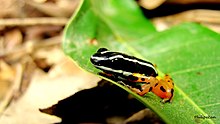Adelphobates quinquevittatus
| Adelphobates quinquevittatus | |
|---|---|

| |
| Scientific classification | |
| Domain: | Eukaryota |
| Kingdom: | Animalia |
| Phylum: | Chordata |
| Class: | Amphibia |
| Order: | Anura |
| Family: | Dendrobatidae |
| Genus: | Dendrobates |
| Genus: | Adelphobates |
| Species: | A. quinquevittatus
|
| Binomial name | |
| Adelphobates quinquevittatus (Rivero and Serna, 1986)
| |

| |
| Synonyms[2] | |
| |
The Rio Madeira poison frog or Amazonian poison-arrow frog (Adelphobates quinquevittatus) is a frog. It lives in Colombia.[2][3][1]
Home
[change | change source]Scientists see this frog on the dead leaves on the ground in tropical rainforests.[1]
Many of the places this frog lives are protected parks, for example Parque Estadual de Guajará-Mirím.[1]
Young
[change | change source]The female frog lays eggs on the dead leaves on the ground. After the eggs hatch, the adult frogs carry the tadpoles to water, for example water in bromeliad plants and in the shells of Brazil nuts.[1]
Danger
[change | change source]Scientists say this frog is not in danger of dying out. But people cut down the forests where it lives to make farms, to dig good rocks out of the ground, and make dams for electricity. Fires can also stop the forests where the frog lives.[1]
References
[change | change source]- ↑ 1.0 1.1 1.2 1.3 1.4 1.5 IUCN SSC Amphibian Specialist Group (2023). "Rio Madeira Poison Frog: Adelphobates quinquevittatus". IUCN Red List of Threatened Species. 2023: e.T55197A89201174. doi:10.2305/IUCN.UK.2023-1.RLTS.T55197A89201174.en. Retrieved October 20, 2024.
- ↑ 2.0 2.1 Frost, Darrel R. "Adelphobates quinquevittatus (Rivero and Serna, 1986)". Amphibian Species of the World, an Online Reference. Version 6.0. American Museum of Natural History, New York. Retrieved October 20, 2024.
- ↑ "Adelphobates quinquevittatus (Rivero and Serna, 1986)". AmphibiaWeb. University of California, Berkeley. Retrieved October 20, 2024.

